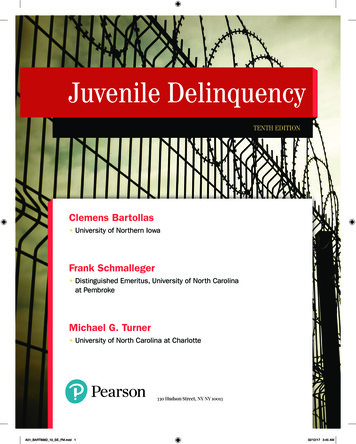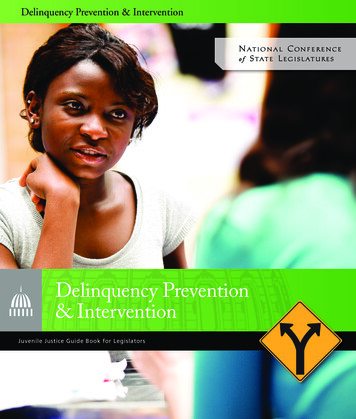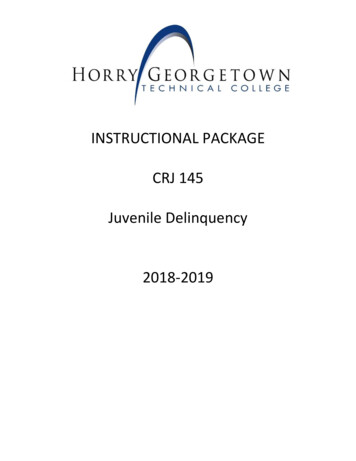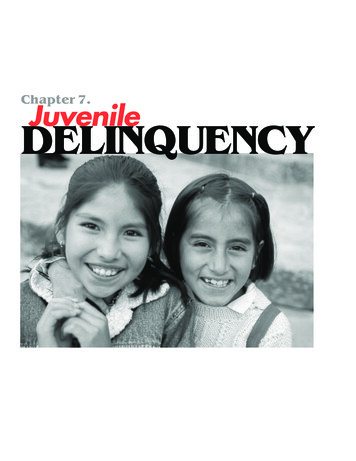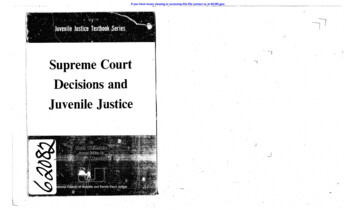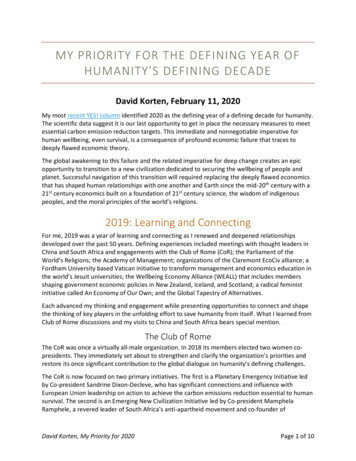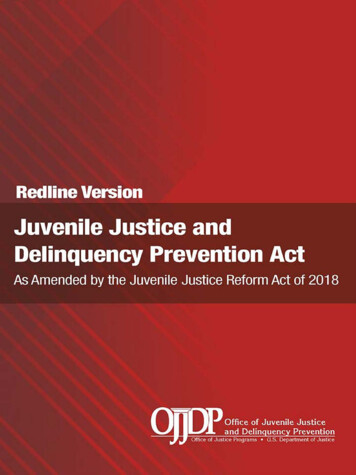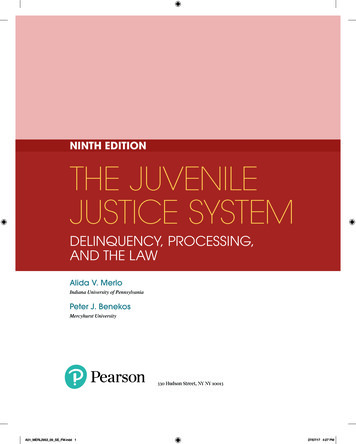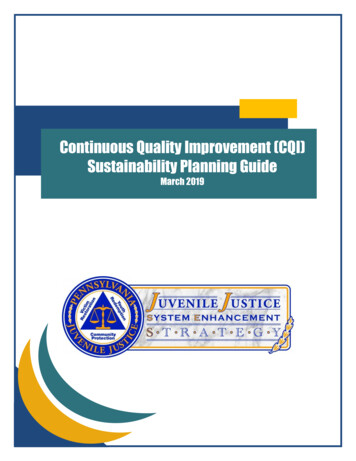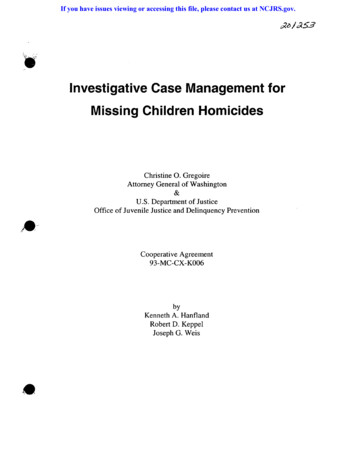
Transcription
Defining JuvenileDelinquency 2The social construction of “juvenile delinquency”Invention of the juvenile courtThe second revolution: transformation of juvenile justice thought andpracticeLegal definitions of “juvenile delinquency”After completing this chapter, students should be able to: Identify the major historical developments that led to the socialconstruction of “juvenile delinquency” as a social and legal concept.Describe the roots of the juvenile court in nineteenth-centurydevelopments such as poor laws, houses of refuge, placing-out, reformschools, and the child-saving movement.Describe the character of the original juvenile court—its philosophy,jurisdiction, and procedures.Distinguish four legal categories of juvenile delinquency.Understand key terms:social constructionist perspectiveparens patriaepoor lawspauperismhouses of refuge15
16 JUVENILE DELINQUENCY: AN INTEGRATED APPROACHplacing-outreform schoolschild-saving movementrehabilitative ideal“best interests of the child”due process of lawstatus offenderbalanced and restorative justicestatus offenseJuvenile delinquency, as we know it today, is a relatively recent concept. Thisdoes not mean, however, that young people in the past were more compliantthan they are today. In fact, Socrates (470–399 BCE) offered a critique thatCASE INThe “Stubborn Child Law”Deuteronomy 21:18–2118If a man has a stubborn and rebellious son who does not obey hisfather and mother and will not listen to them when they disciplinehim, 19 his father and mother shall take hold of him and bring himto the elders at the gate of his town. 20 They shall say to the elders,“This son of ours is stubborn and rebellious. He will not obey us. Heis a profligate and a drunkard.” 21 Then all the men of his town shallstone him to death. You must purge the evil from among you. All Israel will hear of it and be afraid.In November 1646, the governing body of Massachusetts Bay Colony tookthese verses almost verbatim and made them into law. The colonial codes ofConnecticut, Rhode Island, and New Hampshire followed suit. Though substantially amended, the Massachusetts law remained in effect until 1973.In his book, Stubborn Children: Controlling Delinquency in the UnitedStates, 1640–1981, John Sutton points out that “the ‘stubborn child law’ waslegally distinctive in three ways: (1) It defined a special legal obligation thatpertained to children, but not to adults; (2) it defined the child’s parents asthe focus of that obligation; and (3) it established rules to govern when public officials could intervene in the family and what actions they could take.”While the “bare words” of these stubborn child laws made it a capital offensefor a child to disobey parents, they also “established rules to govern whenpublic officials could intervene in the family and what actions they couldtake.” We will explore this new approach to child misconduct in this chapter.Source: Sutton, Stubborn Children, 11–12, numbers added.
Defining Juvenile Delinquencysounds amazingly contemporary: “The children now love luxury. They have badmanners, contempt for authority, they show disrespect for adults and love to talkrather than work or exercise. They no longer rise when adults enter the room.They contradict their parents, chatter in front of company, gobble down food atthe table, and intimidate teachers.”1 So it seems that a concern over the “nextgeneration” is perennial.2Scholars say that juvenile delinquency was “invented” or socially constructed in order to indicate that the concept is a product of a great many social,political, economic, and religious changes. With regard to juvenile delinquency,these changes began in the Renaissance (roughly 1300–1600), but were mostpronounced during the Enlightenment (mid-1600s–late 1700s) and the Industrial Revolution (1760–mid 1900s).3 This transformation of thought and practice eventually led to a series of legal changes at the end of the nineteenthcentury that created the legal status of “juvenile delinquent” and a separate legal system that included juvenile courts and reformatories.4 The use of a separate legal status and legal system for juveniles spread rapidly throughout theUnited States in the early twentieth century. It was not long, however, before thelegal philosophy of the juvenile court began to be seriously questioned. Beginning in the 1960s, a “second revolution” significantly altered contemporary definitions of juvenile delinquency and practices of juvenile justice.5Using a social constructionist perspective, this chapter traces the historicalorigins and recent transformations of juvenile delinquency as a legal concept.We also consider the associated changes in juvenile justice practices. As our perspectives toward juvenile delinquency have changed, so too has our legal response to it. Focusing on this correspondence, this chapter covers four areas: (1)the social construction of “juvenile delinquency,” (2) the invention of the juvenile court, (3) the transformation of juvenile justice systems, and (4) the legaldefinitions of “juvenile delinquency.” The Social Constructionof “Juvenile Delinquency”At least three historical developments led to the social construction of “juveniledelinquency”: the “discovery” of childhood and adolescence, the English common law doctrine of parens patriae, and the rise of positivist criminology. As aresult, the concept of juvenile delinquency came to signify a separate and distinct status for young people, both socially and legally. Sociologists use the concept status to refer to the position or rank of a person or group within society,with the position being determined by certain individual or group traits.6 Juvenile delinquency is a status determined both by age (less than the legal age ofmajority) and behavior (actions that violate the law).The Discovery of Childhood and AdolescenceToday, we take for granted that childhood and adolescence are separate stages inlife, unique from other stages. As Socrates’ critique of youth indicated, the Greeksalso considered this age group distinctive. Both Plato (about 427–347 BCE) and 17social constructionistperspective An attemptto understand the manysocial, political, andeconomic factors that leadto the development of anidea, concept, or view.
18 JUVENILE DELINQUENCY: AN INTEGRATED APPROACHAristotle (384–322 BCE) offered commentary that distinguished and categorized the behaviors, attitudes, and emotions of young people as different fromthose of people at other ages. While their characterizations suggest that theGreeks considered adolescence a separate stage of life, they advance a rathernegative view toward youth, suggesting that, by modern standards, the Greekswere not very understanding of the trials and tribulations of adolescence.7Throughout the Middle Ages (476–1450 CE), European literature made frequent reference to the “ages of life.” This literary theme included seven stages,beginning with infancy and ending with old age; the third stage was adolescence. Shakespeare, for example, refers to the seven stages of life in his famouspassage:All the world’s a stageAnd all the men and women merely players;They have their exits and their entrances;And one man in his time plays many parts;His acts being seven ages. . . .(As You Like It, II, vii, 139).8However, these age categories lacked distinction and were not used outside ofliterature.9In his widely cited book, Centuries of Childhood, Philippe Aries argues thatthe idea of childhood did not exist in medieval society.10 Basing his argument ona variety of historical records, he contends that during the Middle Ages, few distinctions were made between young people and adults. In fact, the only culturally prescribed age distinction was that of infancy. Young people beyond the ageof five were viewed as adults “on a smaller scale.”11Aries contends that during the late sixteenth and seventeenth centuries noticeable social distinctions associated with childhood began to emerge. “For instance, a special type of dress for children appeared. Moreover, it was not untilthe sixteenth and seventeenth centuries that fables, fairy stories, and nurseryrhymes became the property of children.”12 Renaissance culture, however, failedto differentiate adolescence from childhood.13 Thus, while childhood was established as a separate age category by the seventeenth century, it was not distinguished from adolescence until the late eighteenth century.14The slowness with which the companion concepts of childhood and adolescence emerged during the Renaissance was most likely a result of the harshliving conditions of medieval Europe. As LaMar Empey and Mark Stafford write,“under conditions like these, the cultural prescriptions we consider importanttoday were lacking, especially those provisions for close ties between parent andchild, that stress the importance of the nuclear family, that take delight in the innocence and beauty of children, and that provide long years of total economicsupport for a phase of the life cycle known as childhood.”15Aries claims that the slow development of childhood and adolescence doesnot suggest that “children were neglected, forsaken, or despised.”16 Rather, itsimply signifies a lack of awareness of the special needs of childhood. He acknowledges, however, that attitudes toward children during the Middle Ageswere largely “indifferent” and treatment of children was often harsh and punitive.17 Empey and Stafford expand on this, referring to the pre-Renaissance pe-
Defining Juvenile Delinquencyriod as the “history of indifference to children,” characterized by infanticide,abandonment, poor care of infants, disease and death, and harsh and punitivediscipline.18 Their portrayal of the history of childhood is consistent with theobservations of historian Lloyd deMause, who writes, “The history of childhoodis a nightmare from which we are only beginning to awaken. The further backone goes, the lower the level of child care, and the more likely children are to bekilled, abandoned, beaten, terrorized, and sexually abused.”19Family life and child-rearing emerged as matters of great importance in Renaissance society.20 Numerous treatises and manuals were written in the sixteenth and seventeenth centuries, and many remained popular until theeighteenth century.21 These manuals instructed parents on how to train theirchildren in the “new morality,” involving etiquette, obedience, respect for others, self-control, and modesty.22 The training tools emphasized in these manuals included supervision, strict discipline, and insistence on decency andmodesty. Parents were instructed that they must control what their childrenread, hear, and do.These manuals were clear expressions of a new view of children, childhood,and child-rearing: children began to be viewed as innocent and vulnerable. Itwas the responsibility of parents to protect their children from the evils of a corrupt world and to train them so that they developed moral character and religious faith and devotion.23 Aries summarizes, “The family ceased to be simplyan institution for the transmission of a name and an estate—it assumed a moraland spiritual function, it moulded bodies and souls. The care expended on children inspired new feelings, a new emotional attitude. . . .”24While the Renaissance is often described as an awakening from the darknessof the Middle Ages, the Enlightenment of the eighteenth century constitutes another sharp departure from traditional thinking. Building on the importance oftraining and education stressed in treatises and manuals popular at the close ofthe Renaissance, Enlightenment philosophers elaborated on the newly “discovered” stages of childhood and adolescence.In 1693, John Locke (1632–1704), a physician, wrote Some ThoughtsConcerning Education, a treatise on child-rearing that went through twentysix editions before 1800.25 Because he believed that children are born morallyneutral (blank slates) and mature into a product of the influences of experience, Locke stressed the importance of parents in a child’s life, especially forpurposes of supervision, discipline, and moral training. In many ways,Locke’s work represents a culmination of Renaissance views toward childhood and youth as periods of vulnerability and dependency, requiring protection and training. He used the term “education” not to refer to theimportance of schools, but to stress the importance of training by parents inthe form of child-rearing practices.Another Enlightenment philosopher, Jean-Jacques Rousseau (1712–1778),provided a clear departure from Renaissance views. He argued that people wereinherently good, but that social and political institutions corrupted this goodand caused all sorts of trouble for them: “The Author of Nature makes all thingsgood; man meddles with them and they become evil.”26 As a result, he arguedfor permissiveness in child-rearing, so that parents and schools would not corrupt the innocence of children. 19
20 JUVENILE DELINQUENCY: AN INTEGRATED APPROACHRousseau also pointed to the “distinctive human plight” confronted by adolescents during the transition from childhood to adulthood—a plight characterized by moral and sexual tensions.27 Adolescence is actually one of five stages ofdevelopment that Rousseau advanced in his controversial book, Emile (1762).In this work, Rousseau provided the first systematic consideration of the stagesof development, emphasizing how these stages differ and how these differencesinfluence learning and necessitate appropriate educational methods.28The slow discovery of childhood and adolescence was not complete untilthe Enlightenment, when Rousseau’s idea of developmental stages capped agrowing awareness of age distinctions across the life course. The awareness ofdevelopmental stages and differentiation based on age had important implications for the structure of family life, for child-rearing, and for education. Ideasabout the innocence, vulnerability, and dependence of childhood, as well as themoral and sexual tensions of adolescence, resulted in an increasing emphasis onthe family and school as institutions of socialization. Gradually, the view developed that young people require protection, nurture, supervision, discipline,training, and education in order to grow and mature into healthy and productive adults.29 This point of view culminated in the late 1800s, when it was widelyheld that youngsters needed to be “excused from participation in the larger society while they concentrated on personal growth.”30 This was a significant departure from the harsh lives of children in Medieval Europe and colonialAmerica and their often forced involvement in the labor force during most of theearly Industrial Revolution (beginning about 1760).31 The slow discovery ofchildhood and adolescence is depicted in a timeline in Figure 2-1.The Parens Patriae DoctrineThe development of the English legal doctrine of parens patriae coincides withthe discovery of childhood and adolescence. This far-reaching legal doctrineemerged slowly in the late fourteenth and early fifteenth centuries in responseto a series of cases heard before the English chancery courts.32 Parens patriae became a central tenet of the equity law that was derived from chancery court decisions. Adopted in the United States as a part of the Anglo-Saxon legal traditionAwareness of thedistinctiveness ofyouth“Ages of life” inliterature, but fewdistinctions madebetween youthand adultsSlow discovery ofchildhood and lateradolescenceAncient GreekCivilization (BCE)Middle Ages476–1450 CERenaissance1300–1600Stages ofdevelopment—differences inlearningEnlightenmentmid-1600s–late 1700sFigure 2-1 The Discovery of Childhood and Adolescence. While the ancient Greeks were aware that the ageof youth was distinctive, characterized by distinctive behaviors, attitudes, and emotions, the conception of developmental stages and social differentiation based upon age was “discovered” very slowly beginning in theRenaissance. Childhood and adolescence, as we know the companion concepts today, were not given full expression as developmental stages in the life course until the late nineteenth century.
Defining Juvenile Delinquencyof England, parens patriae provided the fundamental legal authority for the ideaof juvenile delinquency and the early juvenile court.The Latin phrase parens patriae means literally “parent of the country.”33 Asa Renaissance legal doctrine, parens patriae vested far-reaching power in the kingas sovereign and supreme guardian over his land and people—the “king’s prerogative.”34 Chancery courts were established to provide just settlements to disputesbut to do so in a way that maintained the king’s prerogative. These disputes arosemainly with regard to property rights and inheritance. Chancery court decisionssought the orderly transfer of property interests and feudal duties, especially whenthe “crown’s interests” were at stake economically and politically.35Parens patriae provided the king with considerable legal authority to supportand protect the social and political order of English feudal society.36 Attached tothis authority, however, was a duty that the king had to his subjects in return forthe allegiance paid to him. In practice, this duty was concerned primarily withthe social welfare of certain dependent groups. Chancery court cases centeredon three dependent groups: children, those who were mentally incompetent,and those in need of charity.37 Under parens patriae, the king was established asprotector and guardian of these dependent classes.With regard to children, parens patriae was applied most extensively to casesin which the wardship or guardianship of young children was at issue.38 In medieval England, though all infants were considered wards of the king because ofthe king’s prerogative, cases involving the wardship of children of the landedgentry were of primary legal concern.39 These children were heirs to an estate orhad already inherited an estate from a deceased father. Gaining custody and control of these children and their estates through wardship could prove profitablefor relatives.Gradually, the chancery courts extended the doctrine of parens patriae to include the general welfare of children; the proper care, custody, and control ofchildren was to the “crown’s interests.”40 This included the ability of the courtsto assume and exercise parental duties—to act in loco parentis—when parentsfailed to provide for the child’s welfare.41 Implicit in this doctrine are the developmental concepts of childhood and adolescence in which it is the parents’responsibility to protect, nurture, supervise, discipline, train, and educate children. Insuring the general welfare of children was a means to maintain thepower of the monarchy and the feudal structure of English society.42 It is important to note that the chancery courts did not have jurisdiction over childrencharged with criminal offenses. Juvenile offenders were handled within theframework of the regular court system. As a result, the parens patriae doctrine ofequity law “embraced the dependent and not the delinquent child.”43Positivist CriminologyTo say that juvenile delinquency is socially constructed means that it is a product of prevailing thoughts and perspectives. The two historical developments wehave considered so far correspond closely in time and perspective. A third historical development took root somewhat later but had an equally strong influence on the idea of juvenile delinquency. parens patriae Literallymeans “parent of thecountry.” The legalauthority of courts toassume parentalresponsibilities when thenatural parents fail tofulfill their duties.21
22 JUVENILE DELINQUENCY: AN INTEGRATED APPROACHPositivist criminology is an approach or school of thought that emerged inthe last half of the nineteenth century and flourished to such a degree that itcame to dominate the field of study for most of the twentieth century. While positivist criminology will be discussed more fully in Chapter 7, we want to pointout here some of its basic tenets, which have influenced conceptions of juveniledelinquency.First and foremost, positivist criminology is based on positivism—the use ofscientific methods to study crime and delinquency.44 The scientific method involves systematic observation, measurement, description, and analysis so thatscientists can look for, uncover, and draw conclusions about the regularities andpatterns of crime and delinquency. The prospect of a scientific approach to crimeand delinquency quickly became popular because of the hope it offered to better understand and respond to the problem of crime through individual and social improvement.The scientific approach advanced by positivism assumes that crime anddelinquency are caused or determined by identifiable factors. This cause-andeffect relationship is referred to as determinism. Determinism holds that, giventhe presence or occurrence of certain causal factors, crime and delinquency invariably follow. According to positivism, causal factors can be systematically observed and measured, and causal processes can be analyzed and described.The patterns and regularities of crime that early positivist criminologists observed led them to conclude that some people are more likely to commit crimethan others. A number of individual and social characteristics were explored todifferentiate criminals from noncriminals. Public fear of crime in rapidly growing cities also centered on differentiation, and public opinion was often drivenby the belief that immigrant groups who were poor, uneducated, unemployed,and lived according to a foreign culture constituted a “dangerous class.”45Early positivist criminologists often contended that the degree of differencebetween criminals and noncriminals was so great that it was most accuratelyportrayed as a pathology.46 Early versions of positivist thought emphasized biological and psychological differences between criminals and noncriminals,claiming that criminals suffered from individual pathologies such as physiological defects, mental inferiority, insanity, and a tendency to give in to passion.These individual pathologies were usually thought to have biological roots.The rise of sociology as a discipline in the late 1800s was associated with differentiation that emphasized social pathologies related to rapid urbanizationand industrialization. Rapid social change was thought to dissolve the organization of social life, resulting in lack of social control. Accordingly, young peoplewho experienced social pathologies (such as divorce and family disruption, lackof parental supervision, poverty, cultural heterogeneity, and residential instability) were considered more likely to engage in delinquent acts and become adultcriminals, destined for a life of crime.Armed with scientific methods to discover the causes of crime and delinquency, positivist criminologists seek to use this understanding to bring aboutchange in individual criminals and their social environment. Using a medicalanalogy, criminologists in the early 1900s sought effective treatment and rehabilitation, directed at the individual and the social pathologies that caused
Defining Juvenile Delinquencycrime. While the pathological emphasis of positivist criminology gives the impression that criminality is determined and therefore unchangeable, the use ofthe scientific method to uncover the causes of crime gave hope that thesepathologies could be understood and treated. The rehabilitative ideal emergedand prospered, especially with regard to children and adolescents.47 CharlesCooley, a well-known sociologist, writing in 1896, declared: “when an individual actually enters upon a criminal career, let us try to catch him at a tender age,and subject him to rational social discipline, such as is already successful inenough cases to show that it might be greatly extended.”48 Invention of The Juvenile CourtThe concept of “juvenile delinquency” is a clear expression of the three historical developments we described: the discovery of childhood and adolescence, theEnglish equity law doctrine of parens patriae, and the growing dominance ofpositivist thought in criminology. The legal designation of a “delinquent child”is an important part of the legislation that created the first juvenile court in theUnited States in 1899. In this section, we trace the evolution of thought andpractice that led to the origins of the juvenile court.Poor Laws, Charities, and PauperismColonial America widely accepted the Christian theology of original sin, andmany people believed that poverty and crime were expressions of this naturaldepraved state. Based on this view, three social institutions were emphasized incolonial times: family, church, and community. David Rothman writes, “Families were to raise their children to respect law and authority, the church was tooversee not only family discipline but adult behavior, and the members of thecommunity were to supervise one another, to detect and correct first signs of deviancy.”49 When these institutions functioned well, towns were “spared the turbulence of vice and crime” and “enjoyed a high degree of order and stability.”50However, when these institutions were unable to change the “sin nature” of children, a strong, uncompromising response was thought to be necessary. As wehave already seen, “stubborn child laws” were developed in colonial America to“establish rules to govern when public officials could intervene in the family andwhat actions they could take.”In accordance with the Enlightenment concepts of childhood and adolescence, colonial Americans took family life and parenting very seriously. Benjamin Wadsworth, a minister and author of the popular child-rearing booklet,The Well-Ordered Family (1712), charged parents to “train up a child in the waywherein he should go” (Proverbs 22:6). Parents were to “govern their childrenwell, restrain, reprove, correct them as there is occasion,” and in so doing, instillmoral integrity, self-reliance, and civic responsibility.51Civic responsibility was a strong obligation in colonial America. It generatedindividual and social obligation to the poor, first informally, and then throughformal provisions of law. In fact, the first colonial poor laws, legislated in the latter part of the seventeenth century, stipulated a community obligation to support 23
24 poor laws Laws enacted incolonial America thatestablished a civic duty ofprivate citizens to“relieve” the poor. Theselaws usually provided adefinition of residence sothat outsiders could notbenefit from private relief.Legal authority was alsogranted for governmentalagencies or private reliefsocieties to separate poorchildren from their“undeserving” parents.pauperism The view,popularly held throughoutthe nineteenth century,that children growing upin poverty, surrounded bydepravity in theirneighborhood and family,are destined to lives ofcrime and degradation.JUVENILE DELINQUENCY: AN INTEGRATED APPROACHand “relieve” the poor. However, these local statutes merely stated the obligation,without specifying who should be considered “poor” or what provisions were tobe provided to the poor.52Colonial poor laws mirrored, but did not merely duplicate, those that haddeveloped earlier in sixteenth-century England.53 Sharing similar philosophyand purpose with the parens patriae doctrine, colonial communities (and latercities and states) developed a system for protecting poor children and, if necessary, separating them from their “undeserving parents.”54 This system grewto include laws, passed by local legislative bodies, regulating the poor; the creation of charitable organizations and relief societies; and, especially in urbanplaces, government-sponsored institutions. Poor laws provided legal authorityfor governmental entities and authorized private philanthropic agencies to separate poor children from their parents and to apprentice these children to local residents. The apprenticeship system kept relief costs down because thechild’s labor paid for care, education, and training. However, the overall quality of the care and training was questionable, and in many cases, apprenticeship was merely a “business proposition” in which the child provided slavelabor for a term.55Gradually, the view developed that poverty, if left unchecked, will lead children to “a future of crime and degradation,” a process known throughout muchof the nineteenth century as pauperism.56 This point of view contrasted sharplyfrom the doctrine of original sin, widely accepted in earlier times. Instead of focusing on the sinful nature of individuals, pauperism emphasizes a breakdownin social order.57The working assumption of pauperism led to the creation of various institutions to help the poor. Institutional charity was thought to be superior tophysical and nutritional care offered in the home, or financial support paid tothe poor, because these noninstitutional forms of relief were thought to have“ ‘pauperized’ the poor by creating habits of idleness and dependency.”58 Institutional relief efforts included the almshouse, workhouse, and poor house,which sought to motivate the poor out of poverty by hard work and strict discipline.59 However, reformers soon realized that these institutional settings couldsimilarly pauperize children by exposing them to adults “addicted to idlenessand intemperance.”60Houses of Refuge and Moral ReformIn the first quarter of the nineteenth century, the state’s parental authority derived from poor laws, and institutional efforts to respond to pauperism becameincreasingly focused on the plight of urban poor children. Because of the fear ofpauperism, reformers were most concerned about the placement of poor children into pauper institutions, such as the municipal almshouse, “where they areliable to acquire bad habits and principles, and lay the foundation for the careerof w
15 Defining Juvenile Delinquency 2 The social construction of “juvenile delinquency” Invention of the juvenile court The second revolution: transformation of juvenile justice thought and practice Legal definitions of “juvenile delinquency” After completing this chapter, students should be able to: Identify
